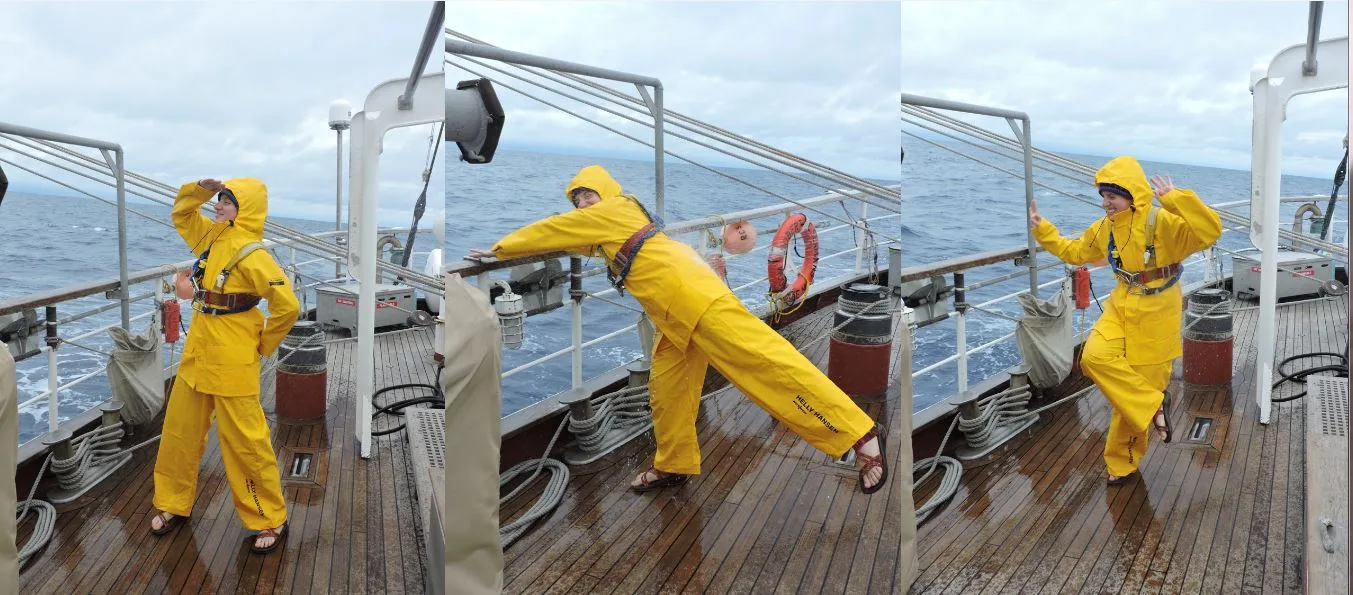Programs Blog
The Folly of Foulies

Ship’s Log
Current Position
21°59.48’S x 177°49.60’W
Ship’s Heading and Speed
270 and 6.2 knots
Weather
Morning/afternoon scattered showers 24°C. Night windy and clear.
At the helm, the wheel jerking my arms along with the swells, I struggled to see the heading as rain sheeted sideways into my face, leaving only one eye functional. The dull red light that normally lights up the compass at night blocked by the rain drops resting on the top of the compass dome. Strong, unpredictable winds, combined with angsty swells, made for perfect squally weather – and the first time I felt like a true sailor. It was mostly the feeling of incredible physical discomfort and stress, along with sights of incredible beauty that allowed me to reach this conclusion. Although I was cold, shivering, and struggling to stay on the course ordered of 240, I marveled at the wave crests sparkling with bioluminescence. Through the rain, I would glimpse little galaxies of shining zooplankton and phytoplankton as waves crashed against one another. My self-designation as a true sailor also came from going full “duck mode” for the first time, or wearing my full outfit of absurdly bright foulies.
Foulies, or foul weather gear, are made of blocky layers of plastic, almost like an extra thick rain coat. Many are bright orange or yellow, to increase visibility in rough weather conditions. Foulie outfits consist of bibs, or clown like overalls that never seem to fit right, and a bulky raincoat. Although all students on board have a full outfit of foulies, only the raincoats had made an appearance before yesterday night, where the weather finally prompted the full “duck mode.” The combination of walking with a wide stance, slightly bowlegged in order to counter the rocking of the boat, the bright yellow color of most foulies on board, and the strange scrunched hood that tops the outfit, “duck mode” seems to be the perfect description for the hunky weather gear. As the wet rubber chafes together when walking, the small squeeks could almost be interpreted as the “quack, quack” of a duck.
Of course, an explanation of foulies would not be complete without a photo shoot. I modeled my foulies in daylight today in order to showcase them in their full glory. Rocky, the mate for A Watch, was nice enough to spray me with the salt water hose for authenticity.
Finally, a special shoutout to my mom for always picking up the phone when I call at strange hours, my dad, my two brothers, Justin and Ethan, my dog Princess, and my cat MoBurger!
Catch you on the flippity flip,
– Arielle Landau, A-Watch, Middlebury College
Recent Posts from the Ships
- Ocean Classroom 2024-A collaborative high school program with Proctor Academy
- Collaborations and Long-term Commitments: SEA’s Caribbean Reef Program Sets a Course for Coastal Programs that Compliment Shipboard Experiences.
- Sea Education Association students prepare for life underway using state of the art nautical simulation from Wartsila Corporation.
- SEA Writer 2022, Magazines From the Summer SEA Quest Students
- Technology@SEA: Upgrades Allow Insight into Ocean Depths
Programs
- Gap Year
- Ocean Exploration
- High School
- Science at SEA
- SEA Expedition
- SEAScape
- Pre-College
- Proctor Ocean Classroom
- Protecting the Phoenix Islands
- SPICE
- Stanford@SEA
- Undergraduate
- Climate and Society
- Climate Change and Coastal Resilience
- Coral Reef Conservation
- Marine Biodiversity and Conservation
- MBL
- Ocean Exploration: Plastics
- Ocean Policy: Marine Protected Areas
- Oceans and Climate
- Pacific Reef Expedition
- The Global Ocean: Hawai'i
- The Global Ocean: New Zealand